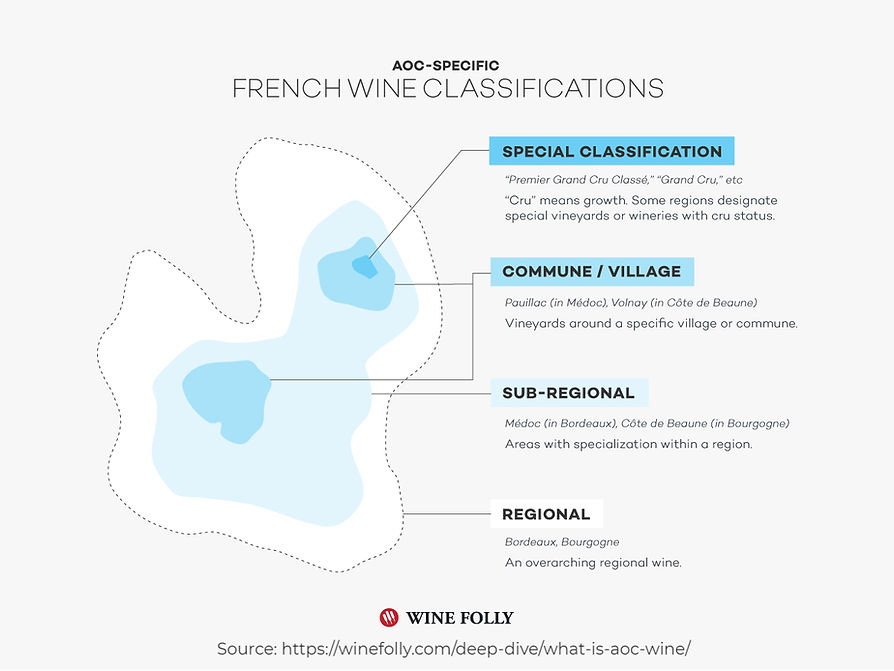

French Wine Classifications
Date: 23 July 2024 by Vinescapade Team
French Wine Classifications: Understanding the System
France is renowned for its wine, and the French wine classification system is key to maintaining the quality and reputation of its wines. The system is complex, but understanding the basics can enhance your appreciation and selection of French wines. This guide integrates information from various sources to provide a comprehensive overview.
The Basic Classifications
1. Appellation d’Origine Contrôlée (AOC)
AOC, short for Appellation d’Origine Contrôlée, represents the highest level of French wine classification. It denotes a wine that adheres to strict geographical and production regulations to ensure quality and authenticity. Established in 1935 by the INAO (Institut National de l’Origine et de la Qualité), the AOC system aims to protect the reputation of regional wines and promote high-quality production standards. There are several sub-categories within AOC, reflecting the wine's location and quality:
-
Regional AOC: Covers broad areas like Bordeaux or Burgundy.
-
Sub-Regional AOC: More specific areas within regions, such as Médoc in Bordeaux or Chablis in Burgundy.
-
Commune/Village AOC: Narrower areas often just a few miles in scope, like Pauillac in Médoc.
-
Cru: Indicates a specific vineyard or group of vineyards recognized for their superior quality, such as Grand Cru or Premier Cru in Burgundy.
AOC wines must meet stringent criteria, including permitted grape varieties, maximum yields, vine age, and harvesting methods. The AOC label is a guarantee of origin and quality.
2. Indication Géographique Protégée (IGP)
IGP, formerly known as Vin de Pays, translates to "Protected Geographical Indication." This classification offers more flexibility than AOC, allowing winemakers to use different grape varieties and production methods. IGP wines are subject to fewer restrictions but must still meet certain standards related to grape variety, alcohol content, acidity, and sulfur levels.
IGP wines can display their vintage and grape varieties on the label. There are three types of IGP wines:
-
Regional IGP: Covers large areas like Pays d’Oc in Languedoc.
-
Departmental IGP: Specific to French départements, similar to counties.
-
Zonal IGP: Smaller areas with a consistent terroir, potentially candidates for AOC status.
IGP wines offer a diverse range of styles and are often more affordable while still maintaining good quality.
3. Vin de France
Vin de France, previously known as Vin de Table, represents the most basic level of French wine. These wines can be made from grapes grown anywhere in France and do not follow strict regulations regarding grape variety or production methods. They cannot display the vintage or the specific region on the label. Vin de France wines vary widely in quality and are typically seen as everyday drinking wines.
However, some high-quality wines are labeled as Vin de France because they do not conform to AOC or IGP regulations. For example, innovative winemakers might use non-traditional grape varieties or unique production techniques that fall outside the established rules.
Special Classifications within AOC
Certain regions have additional quality tiers within the AOC designation:
-
Grand Cru: The highest classification, particularly in Burgundy and Bordeaux, indicating the top vineyards or estates. In Burgundy, Grand Cru wines come from the best vineyard sites and are subject to stringent yield limits and aging requirements. In Bordeaux, Grand Cru Classé status is awarded to entire châteaux based on historical classifications from 1855 and later revisions.
-
Premier Cru: A step below Grand Cru but still representing high-quality vineyards. In Burgundy, Premier Cru wines come from excellent vineyards that do not meet the highest criteria of Grand Cru. In Bordeaux, Premier Cru (or First Growth) refers to the top tier of classified growths, particularly from the 1855 classification. (Read more about Grand Crus Wines)
Burgundy and Bordeaux are known for their detailed classification systems, with Burgundy focusing on specific vineyards and Bordeaux on entire châteaux.
Historical and Cultural Context
The concept of terroir, a French term without a direct English equivalent, is central to the French wine classification system. Terroir encompasses the soil, climate, and other environmental factors that influence the quality and character of the wine. French winemakers have long understood the importance of these factors and have developed the classification system to reflect them.
The AOC system was developed in response to the need to protect the reputation of French wines, particularly following the phylloxera epidemic in the 19th century that devastated many vineyards. The system was formalized in the 1930s to establish clear standards and promote high-quality production.
Impact of Climate Change
Climate change poses a growing concern for the French wine industry. Changes in temperature and precipitation patterns can affect grape ripening times, acidity levels, and overall wine quality. This could lead to adjustments in the classification system or the introduction of new grape varieties better suited to the changing climate. Winemakers are increasingly adopting sustainable practices to mitigate the effects of climate change and ensure the longevity of their vineyards.
Conclusion
Understanding French wine classifications can seem daunting, but it’s crucial for appreciating the quality and diversity of French wines. The AOC, IGP, and Vin de France classifications each serve to guide consumers and protect the reputation of French wines. By adhering to strict standards, French wine producers ensure that each bottle reflects the unique characteristics of its region and meets high-quality expectations.
